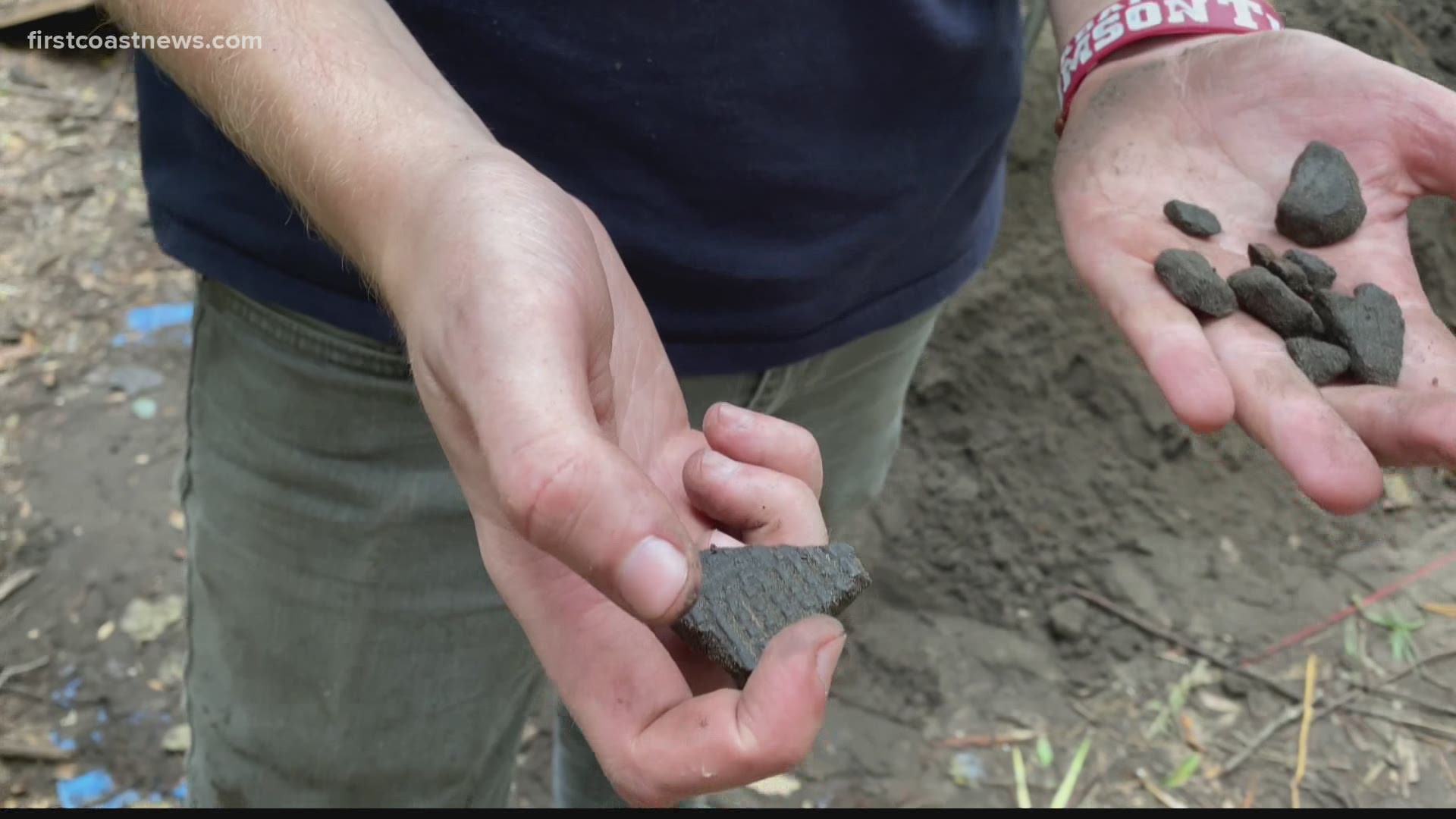JACKSONVILLE, Fla. — *The headline of this story has been altered from its original which was 'UNF students explore remains of ancient villages, a plantation on Big Talbot Island'
Tucked away down a dirt road on Big Talbot Island, one family’s front yard contains what is left of ancient Native American villages and a slave plantation covered beneath it.
University of North Florida students are spending their summer shoveling dirt on the homeowner’s property to find remains of the two villages on the island northeast of Jacksonville. One village, known as the Sarabay, dates to the 1500s while the second unnamed village dates back to 1000 A.D.
Remains from three different historical time periods lie merely feet apart underneath the sticks, leaves and dirt. Keith Ashley, a UNF assistant anthropology professor, is primarily focused on the artifacts from the two villages.
Ashley said the best way to learn about the people is to study what they left behind. “Really, I get excited by just their garbage,” he said.
Since early May, 17 to 24 students at a time have mapped, measured, excavated and sifted what are called units on the land.
Ashley believes the dig site they are at is slightly north of where the Sarabay community lived, and most artifacts they have uncovered are about 1,000 years old.
Though Ashley has worked on Big Talbot Island at nearby sites for the last 20 years, the former property owner did not allow him to dig on the land.
“It was this void in our sampling, so the family allowed us to come out here and do some more testing,” he said. “So now this has helped us to fill in this big gap that we had.”
Ashley said one unit is 1-by-2 meters, or 3-by-6-foot portions of ground. The students dig about 3 feet into the ground and learn about that piece of land from top to bottom.
The units spread around the property are filled with what might seem like ordinary dirt to some.
But 22-year-old anthropology senior Cheyenne Black’s assigned plot contains artifacts no one has likely seen in almost 400 years.
Black drives an hour from her home in Nassau County to the site five days a week. She typically works with anthropology seniors Shelby Foy, 26, and Hannah Blythe, 22, on their assigned portion of the property. This is the three students’ first time participating in the university’s Archaeological Field School summer program.
Each student can receive three to six credit hours for their time in the six-week program.
Ten centimeters at a time, the students scan the dirt. The dirt then goes into buckets.
The buckets are dumped onto screens where they sift out the artifacts.
Pieces of pottery, glass, shell, bone, charcoal and other items are separated into red and blue Solo cups then labeled with black marker as “bones,” “pots” and “miscellaneous.” The remains are later assorted into plastic bags and taken back to the lab.
The main goal of the dig is to discover where these villages were when the Spanish and French arrived, Ashley said. A class will be offered in the fall semester for students to analyze the artifacts found from the site.
The group spends six hours a day barefoot in the dirt together. They recalled finding a whelk shell, which looks similar to a conch shell, as the most exciting part of their dig in the last four weeks.
“We all screamed, and Dr. Ashley came back because he thought we were in trouble,” Blythe said.
At the front of the property, remains have been uncovered from about 900 to 1200 A.D.
Foy said the objects in their unit date to around the 1500s, a time when the Spanish and French were making contact with the village.
Ashley said the artifacts they are finding were from the outer edge of the village. From studying the remains, they can determine that the villagers from 1000 A.D. were fishermen and shellfish collectors who lived successfully off the land without agriculture while the later Sarabay community grew corn.
Students working at another unit feet away found remains of nails, painted ceramic pottery, concrete and part of a tobacco pipe likely from a slave owner’s plantation that was about 100 yards away in the 1800s.
Black picked a small, triangle-shaped dark artifact out of a plastic bag. It was one remain found from Tuesday’s dig, she said. The shard was imprinted with the fibers from a sabal palm that the Native Americans pressed into wet clay. The students passed around the artifact and discussed the small details of the imprints.
“We found a piece of pottery that was one of the biggest pieces we found back here,” Foy said. “They had punctations all the way through, which is just a tiny detail that, to us, is significant.”
Moving forward, Ashley said he hopes he and the students discover remains of housing structures or a household area.
The students are aiming to document the villages and contribute the research to Ashley’s Mocama Archaeological Project, which he began in 2011.
“A lot of the indigenous culture around Jacksonville has kind of been overlooked, and there is not a lot of information on it,” Foy said. “Being able to contribute to something that can speak for people who can’t speak for themselves, who aren’t here anymore is pretty important.”
Angela DiMichele: (904) 359-4697

